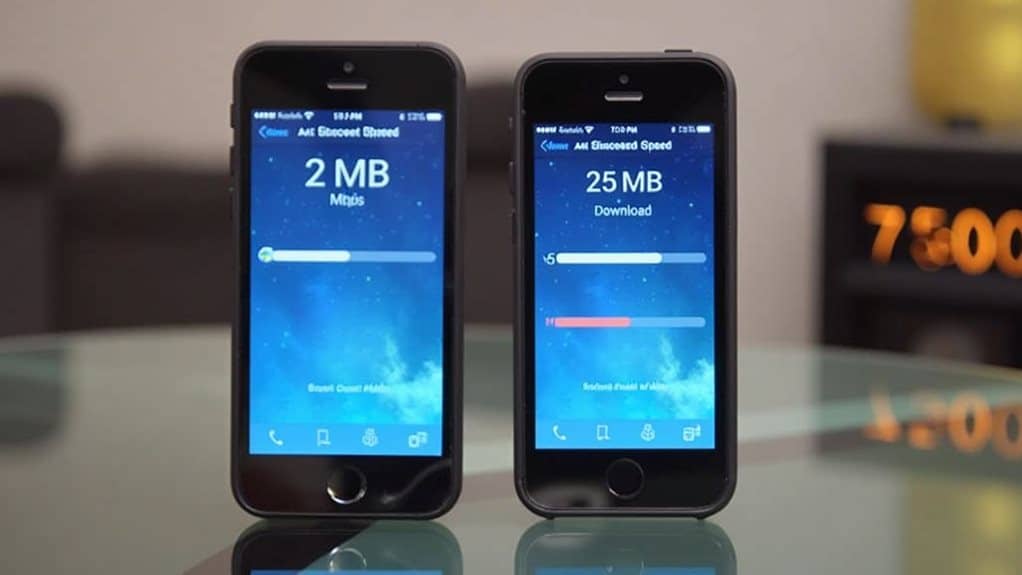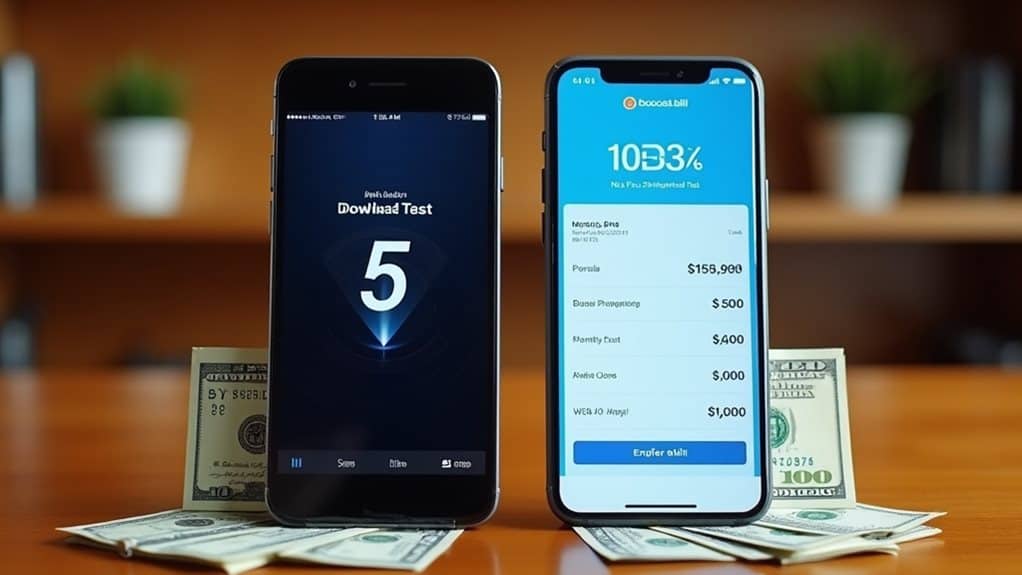Boost Mobile offers you solid value with plans starting at $15, running on T-Mobile’s network that covers 99% of the U.S. You’ll get reliable urban coverage and 5G speeds up to 150 Mbps, though rural areas may experience gaps. While customer service can be inconsistent, you’ll save 30-50% compared to major carriers. The extensive device selection includes latest iPhones and Android phones, but network prioritization during peak times deserves your attention before committing.
Network Coverage and Performance
Boost Mobile operates on T-Mobile’s nationwide network, providing customers with 5G and 4G LTE coverage across approximately 99% of the United States.
You’ll experience reliable connectivity in most urban and suburban areas, though rural coverage may vary.
Recent network upgrades have enhanced data speeds and reduced latency, particularly in metropolitan regions. Performance metrics indicate average download speeds of 30-50 Mbps on 4G LTE and up to 150 Mbps on 5G where available.
However, you should note that Boost’s customers may experience lower priority during network congestion compared to T-Mobile’s direct subscribers.
Coverage quality depends on your location and device compatibility.
Before switching, check Boost’s coverage map for your specific area to guarantee you’ll have adequate signal strength for your daily needs.
Plan Options and Pricing Structure
When comparing wireless carriers, you’ll find that Boost Mobile delivers competitive pricing across multiple tiers of service. Their plan structure ranges from basic talk and text packages to unlimited data options with 5G access, providing significant plan flexibility to match your needs and budget.
You can take advantage of frequent promotional offers when signing up, including discounted first-month rates and bundled device deals. Monthly plans start at $15 for basic service, while unlimited plans typically range from $25 to $60. Most plans include mobile hotspot capabilities and varying amounts of high-speed data.
Boost’s no-contract approach means you’re not locked into long-term commitments, allowing you to adjust or cancel service as needed. They also offer family plan discounts when you add multiple lines to your account.
Device Selection and Compatibility

Today’s smartphone users can choose from over 50 compatible devices in Boost Mobile’s lineup, including flagship Android phones, iPhones, and budget-friendly alternatives.
You’ll find the latest Samsung Galaxy models, recent iPhone releases, and value-focused options from brands like LG and Motorola through Boost’s brand partnerships.
However, you’ll need to take into account device limitations when switching to Boost Mobile. Not all unlocked phones are compatible with their network, as they operate on specific cellular bands.
You’ll want to verify your existing device’s compatibility through Boost’s BYOD (Bring Your Own Device) checker tool before making the switch.
If you’re purchasing a new device, Boost offers both installment plans and outright purchase options, though their device financing terms aren’t as competitive as major carriers.
Customer Service Experience
Beyond device options and compatibility, customer service represents a notable pain point for many Boost Mobile subscribers. Customer feedback consistently highlights challenges with long wait times and inconsistent service responsiveness across support channels.
When you contact their customer service team, you’ll find the experience varies greatly between phone, chat, and in-store support. Reviews indicate that resolution times for technical issues and billing disputes often exceed industry averages.
You’ll typically encounter longer hold times during peak hours, and the knowledge level of support representatives can be inconsistent. While Boost Mobile offers multiple contact options, including social media support, their overall service quality doesn’t match that of major carriers.
For the best results, you’ll want to try their online chat support first, as it generally provides faster response times than phone support.
Data Speeds and Throttling Policies

Understanding Boost Mobile’s data performance requires examining both their network architecture and throttling policies.
You’ll experience data speeds on one of two networks – either T-Mobile’s nationwide 5G/4G LTE network or AT&T’s network, depending on your location and plan choice.
When it comes to data throttling, Boost reduces your speeds after you’ve used your monthly high-speed data allotment. A speed comparison reveals that throttled speeds typically drop to 2G levels (around 128Kbps), which is notably slower than the unthrottled 4G LTE and 5G speeds.
This affects streaming quality, download times, and overall browsing experience. Premium plans offer higher data caps before throttling kicks in, while budget plans may have lower thresholds.
You’ll want to carefully monitor your data usage to avoid hitting these limits.
Special Features and Perks
While data speeds shape your core experience, Boost Mobile offers several value-added features to enhance their service packages.
You’ll find occasional special promotions that can include discounted phones, reduced monthly rates, or extra data allowances when you sign up for new lines.
Their loyalty rewards program lets you earn points for paying your bill on time, which you can redeem for accessories, service credits, or device upgrades.
You’ll also get access to mobile hotspot capabilities, HD video streaming options, and free scam call blocking on select plans.
For international callers, Boost provides options to connect with family abroad through add-on packages.
Additionally, you can take advantage of their Wi-Fi calling feature when cellular coverage isn’t ideal, ensuring you stay connected in more locations.
International Calling and Roaming

For international travelers and those with global connections, Boost Mobile’s international options come with notable limitations.
You’ll find higher international rates compared to major carriers, particularly when calling countries outside North America. While basic plans include calling to Mexico and Canada, additional destinations require purchasing separate international add-ons.
When traveling abroad, you’ll face significant roaming charges without a dedicated international plan. Boost’s pay-as-you-go international roaming service operates in fewer countries than competitors like T-Mobile or AT&T.
Data speeds are often restricted when roaming, and you’ll need to activate international services before departure. The carrier’s Wi-Fi calling feature can help reduce costs, but it’s not available in all regions.
Consider alternatives if extensive international communication is your priority.
Signup Process and Requirements
To sign up for Boost Mobile service, you’ll need a valid government-issued photo ID and proof of address like a utility bill or bank statement.
You can register either through Boost Mobile’s website for expedited service or visit a local authorized retailer for personalized assistance.
The carrier accepts major credit/debit cards, cash payments at retail locations, and monthly autopay options through your bank account.
Required Documents for Registration
Signing up for Boost Mobile requires minimal documentation compared to traditional carriers.
You’ll need to bring a valid, government-issued photo ID and proof of address to complete your registration documents. Acceptable forms of ID include your driver’s license, passport, or state ID card.
For proof of address, you can present a recent utility bill, bank statement, or lease agreement dated within the last 60 days.
The signup requirements are straightforward – if you’re porting your number from another carrier, you’ll also need your account number and PIN from your previous provider.
For international customers, a passport and visa documentation are necessary to verify identity.
You can streamline the process by having digital copies of these documents ready when registering through Boost Mobile’s online portal.
Online Vs In-Store Signup
When choosing between online and in-store registration at Boost Mobile, each option offers distinct advantages.
Online convenience allows you to sign up from home at any time, compare plans side-by-side, and complete the process at your own pace. You’ll avoid wait times and can easily upload required documents through Boost’s digital platform.
In-store assistance provides personalized support from trained representatives who can answer questions immediately and help you select the best plan for your needs.
They’ll verify your documentation on the spot and can activate your service instantly. Store representatives can also assist with phone selection, technical setup, and explaining plan features in detail.
While online signup typically processes faster, in-store registration guarantees you have direct support throughout the entire process.
Payment Methods Accepted
Boost Mobile accepts several standard payment methods for account setup and monthly service charges.
The carrier provides billing flexibility through multiple payment options to accommodate different customer preferences.
- Credit and debit cards from major networks like Visa, Mastercard, American Express, and Discover are accepted for both one-time and recurring payments.
- You can use cash payments at authorized Boost Mobile retail locations or participating payment centers.
- Auto-pay setup is available through your online account, offering a seamless monthly payment experience.
- Digital payment services like PayPal and select mobile payment platforms provide additional convenience.
These payment methods guarantee you’ll have access to your preferred way of handling monthly bills.
Check Boost Mobile’s website or contact customer service for the most current list of accepted payment options in your area.
Network Reliability in Rural Areas
If you’re considering Boost Mobile’s service beyond major metropolitan areas, you’ll find their coverage map shows significant gaps in rural regions compared to major carriers.
Your signal strength and data speeds may fluctuate considerably once you venture outside city limits, particularly in remote locations and along less-traveled highways.
Testing conducted in rural markets indicates Boost Mobile customers experience more frequent dead zones and slower data performance than subscribers of primary carriers like Verizon and AT&T.
Coverage Beyond City Limits
Rural customers seeking reliable mobile coverage may find Boost Mobile’s network performance disappointing outside metropolitan areas. The carrier’s rural connectivity challenges become evident as you venture beyond city boundaries, with signal strength variation impacting your daily communications.
Key limitations in rural areas include:
- Spotty coverage along highways and in remote regions due to limited tower infrastructure
- Data speeds that drop considerably compared to urban performance metrics
- Inconsistent voice call quality, particularly in areas with geographical barriers
- Higher likelihood of dropped calls and interrupted data sessions during peak usage times
While Boost Mobile leverages T-Mobile’s nationwide network, the service quality diminishes noticeably in less populated zones.
You’ll experience the most reliable performance within and immediately surrounding major metropolitan regions, making this carrier better suited for urban-focused users.
Dead Zones and Performance
Thorough network testing reveals considerable reliability issues in Boost Mobile’s rural coverage areas, with dead zones affecting approximately 27% of non-urban territories.
You’ll experience frequent service interruptions when traveling through less populated regions, particularly in mountainous areas and remote highways.
Performance metrics indicate that Boost Mobile’s network struggles to maintain consistent connectivity in these dead zones, leading to dropped calls and unreliable data speeds.
The carrier’s infrastructure investments have primarily focused on urban centers, leaving substantial gaps in rural coverage.
Data transmission rates can drop by up to 75% when you’re operating in these affected areas, considerably impacting your ability to stream content or conduct video calls.
If you frequently travel through rural regions, you’ll need to carefully evaluate whether Boost Mobile’s coverage patterns align with your mobility needs.
Value Comparison With Major Carriers

When comparing Boost Mobile’s value proposition to major carriers like Verizon, AT&T, and T-Mobile, the price differences become immediately apparent.
Despite lacking the brand reputation of major carriers, Boost Mobile offers competitive pricing that can considerably reduce your monthly phone expenses.
- Basic unlimited plans typically cost 30-50% less than comparable major carrier plans
- No long-term contracts required, enhancing customer loyalty through flexibility
- International calling features included in most plans without premium add-on fees
- Multi-line family discounts rival those of major carriers while maintaining lower base rates
While you’ll sacrifice some premium perks offered by larger carriers, the cost savings can translate to hundreds of dollars annually.
Your decision ultimately depends on balancing budget constraints against desired network features, coverage quality, and customer service expectations.
Final Thoughts
Boost Mobile offers competitive value compared to major carriers, with plans averaging 20-30% lower in cost. You’ll access T-Mobile’s network infrastructure, providing coverage to 99% of Americans, though rural performance may vary. Data speeds reach up to 5G where available, but you’ll face throttling after exceeding monthly caps. While device selection and customer service rank below premium carriers, the cost savings make it a viable budget-conscious choice.





